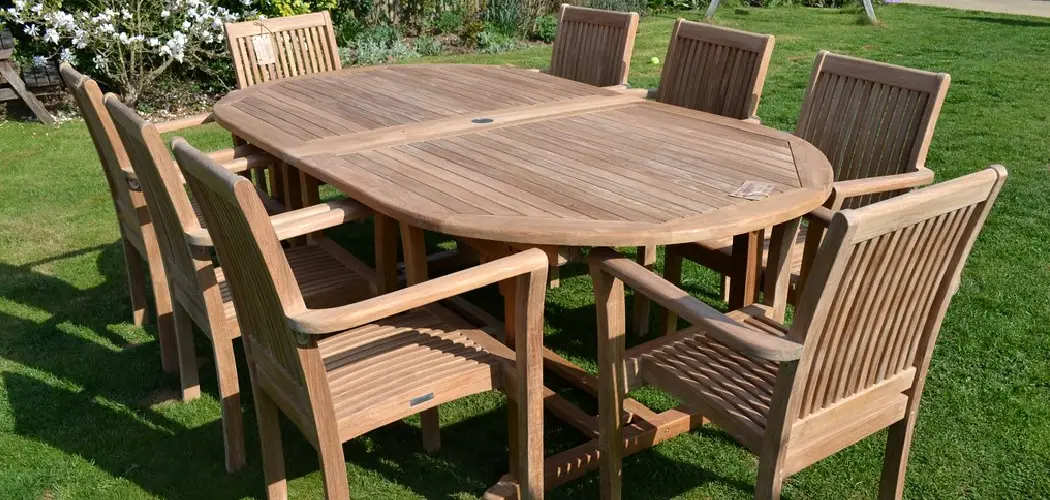Are your outdoor wood furniture pieces looking a bit worse for wear? Don’t toss them in the trash yet! Refinishing outdoor wood furniture can be a surprisingly easy DIY project that will restore each piece to its former glory and help it last another year or two longer.
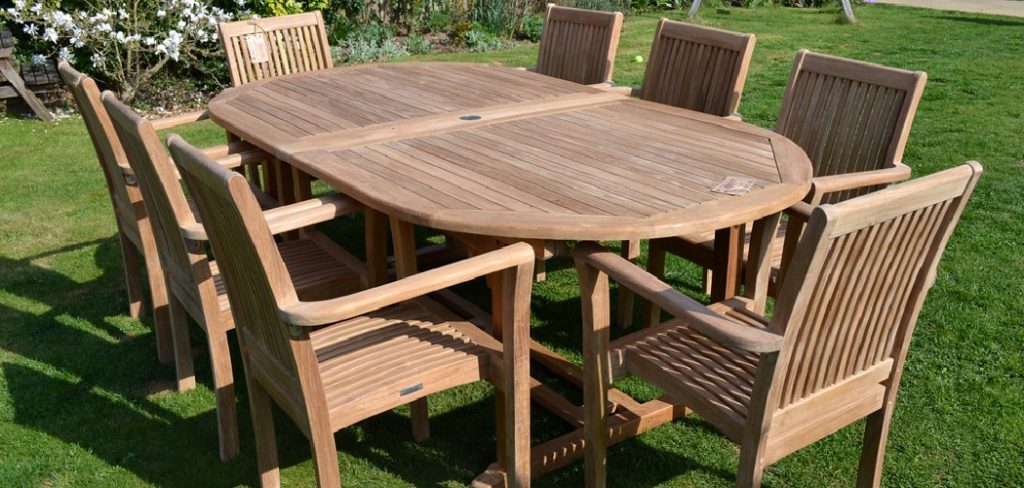
This step-by-step guide will show you how to refinish outdoor wood furniture without spending too much time, effort, or money. With just a few simple tools and supplies, you’ll have your favorite patio pieces back in tip-top shape before summer arrives. Read on to learn more about reviving your outdoor furnishings!
What Kind of Stain to Use on Outdoor Wood Furniture?
When refinishing outdoor wood furniture, it’s important to use a stain that is designed for outdoor use. This will ensure that the finish is long-lasting and resistant to fading, chipping, and cracking in harsh weather conditions.
Oil-based or water-based semi-transparent stains are a popular choice for outdoor wood furniture because they provide a protective seal while still allowing some of the natural grain to show through. For example, teak oil is a great option for teak furniture because it enhances the wood’s natural color and gives it an attractive glossy finish.
If you want more color variety with your stain, look for semi-solid or solid colors. These types of stains offer more coverage and will help hide blemishes or imperfections in the wood.
It’s also important to consider the type of finish you want for your outdoor furniture. Some people prefer a matte finish, while others like a glossy sheen. Oil-based stains tend to provide more of a glossy finish than water-based stains, but if you’re looking for something with a bit more shine, then look for a varnish or urethane product that can be applied over the stained wood.
No matter what kind of stain you decide to use on your outdoor wood furniture, make sure it is specifically designed for outdoor use so that it can withstand the wear and tear of weathering elements such as rain and sun exposure. With the right kind of stain and finish, you’ll be able to enjoy your outdoor furniture for years to come.
9 Steps How to Refinish Outdoor Wood Furniture
Step: 1. Stripping the Old Finish
The first step in refinishing outdoor wood furniture is to strip the old finish off of the piece. This can be done using a chemical stripper or sandpaper. If you are using a chemical stripper, be sure to follow the instructions carefully and wear protective clothing, as some strippers can be harmful to your skin.

If you are using sandpaper, start with a coarse grit and work your way up to a finer grit for a smoother finish. To prevent damaging the wood when sanding, move the sandpaper in the same direction as the grain of the wood. Once you have removed all of the old finish, wipe the piece down with a damp rag to remove any dust and debris.
Step: 2. Cleaning the Wood
Once the old finish has been removed, the next step is to clean the wood. This can be done with a mild soap and water solution. Be sure to rinse the piece thoroughly and allow it to dry completely before proceeding to the next step.
To remove any remaining residue, use fine-grit sandpaper to lightly buff the surface. Be careful not to over-sand, as this could compromise the integrity of the wood. Use a tack cloth to remove any sanding dust and debris before applying sealer or stain.
Step: 3. Sanding the Wood
The next step is to sand the wood. This will help to create a smooth surface for the new finish to adhere to. Be sure to use sandpaper with a grit that is appropriate for the type of wood you are working with. For example, if you are working with softwood, you will want to use a finer grit sandpaper than if you were working with hardwood.
Additionally, it is important to sand in the direction of the wood grain to avoid damaging the wood. Once you have finished sanding, use a damp cloth to remove any dust or debris that may have been left behind. While sanding, be sure to wear a dust mask and safety goggles for protection. To ensure a smooth finish, it is best to sand the wood in multiple passes with increasingly finer grits of sandpaper.
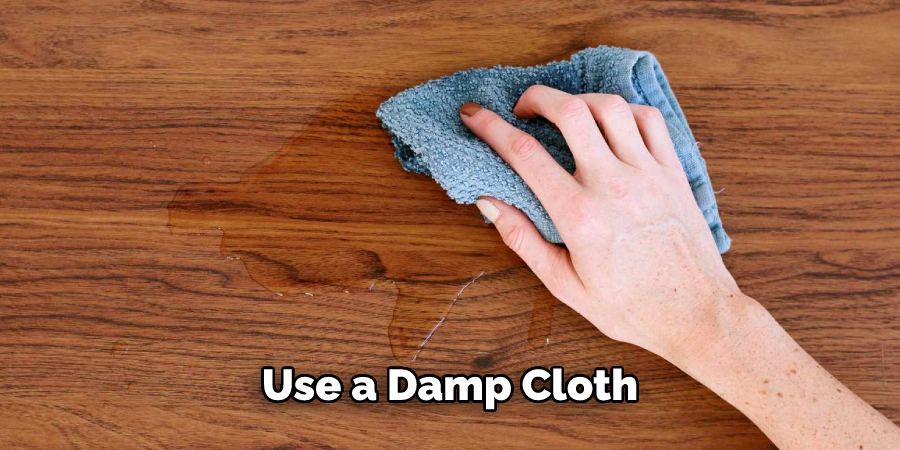
Step: 4. Applying Primer
Once the wood is sanded, the next step is to apply primer. This will help to ensure that the new finish adheres properly and does not chip or peel over time. Be sure to follow the instructions on the primer label carefully and only apply it to areas that will be painted or stained.
Before applying the primer, it is important to make sure that all of the sanding dust has been removed and that the surface is clean. After this is done, the primer can be applied using a brush or roller in thin, even coats. Allow the primer to dry for at least 24 hours before proceeding to the next step.
Step: 5. Painting or Staining
After the primer has dried, you can then proceed to paint or staining your outdoor wood furniture. If you are painting, be sure to choose a paint that is specifically designed for use on outdoor furniture. If you are staining, be sure to choose a stain that is appropriate for the type of wood you are working with. For example, if your outdoor wood furniture is made out of cedar, you should use a cedar-specific stain.
If you are using a paint, it is important to apply multiple thin coats to ensure an even coverage. When applying the stain, be sure to use long, even strokes and wipe away any excess stain that pools on the surface. After all coats have been applied, allow the paint or stain to dry completely before using your newly finished furniture.
Step: 6. Applying Clear Coat
Once you have finished painting or staining your furniture, you may want to apply a clear coat for added protection against weathering and UV rays. Clear coats come in both spray and brush-on versions; however, spray-on clear coats are generally easier to apply and provide better coverage. Be sure to follow the instructions on the clear coat label carefully before applying it to your furniture.
For best results, apply the clear coat in thin coats and allow each coat to dry completely before applying the next. You may need to wait up to 24 hours between each coat of clear coat. When you have finished applying the clear coats, allow your furniture to cure for at least 72 hours before using it. After this time, your furniture is ready for use and will be protected from the elements.
Step: 7. Allow Furniture to Dry Completely
After you have applied all of your desired finishes, it is important to allow your furniture to dry completely before using it or storing it away for winter. Depending on the temperature and humidity levels, this could take anywhere from 24 hours to several days. Once your furniture is completely dry, enjoy your newly refinished piece!
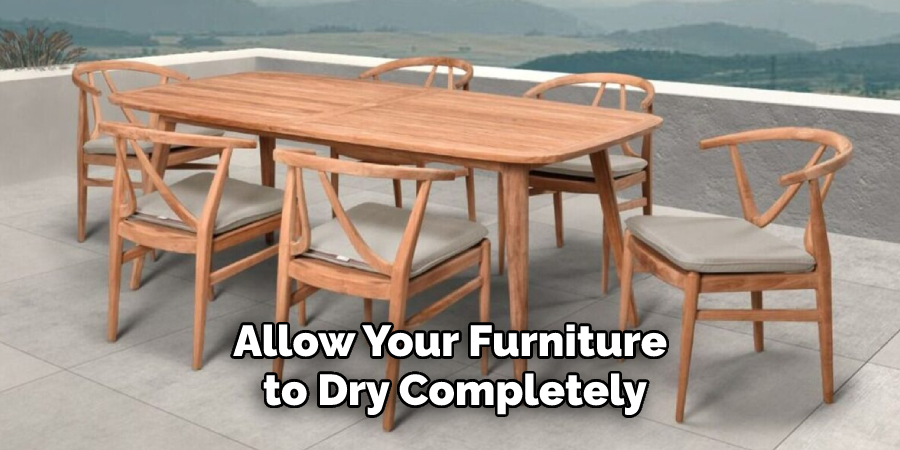
Step: 8. Maintenance
In order to keep your outdoor furniture in top condition, it is important to perform regular maintenance. This includes dusting and wiping down the furniture, often with a slightly damp cloth. If needed, use mild soap and warm water to remove surface dirt. Apply a wood cleaner or brightener to remove grime and restore the wood’s natural luster.
After it is dry, apply a protective finish such as a sealer or stain to help protect the wood from weather and harsh UV rays. This should be done twice a year or more, depending on the amount of exposure to sunlight and rain. It is also important to regularly check for loose screws and bolts and tighten or replace them if necessary.
Step: 9. Furniture Regularly
In addition to dusting and wiping your furniture down regularly, you should also check for signs of wear and tear. If any areas look faded or cracked, you may need to refinish them. You can either use a product that’s specifically designed for outdoor furniture or make your own by mixing a cup of linseed oil with a cup of turpentine.
Apply the mixture to the affected area, let it sit for 15 minutes, and then wipe it off. For tougher blemishes, you may need to sand the area before reapplying the oil mixture. Use fine-grit sandpaper to ensure that you don’t damage the wood too much. Once you’re done, apply a coat of furniture wax or sealant to protect your furniture from future UV damage.
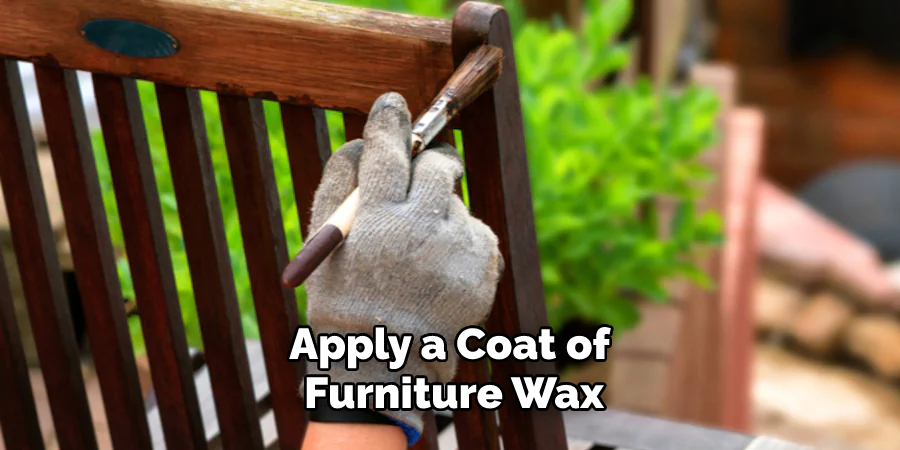
Conclusion
With enough determination and focus, your outdoor furniture will look better than ever — without the hefty pricetag! So next time you head out to buy new furniture for your backyard or patio, stop and think about how you can refinish what you already own — it could end up saving you time and money in the long run! Now that you know How to Refinish Outdoor Wood Furniture – get started on restoring your outdoor furniture today!

